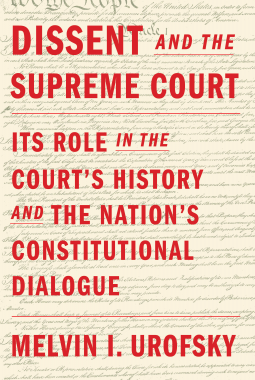
Dissent and the Supreme Court
Its Role in the Court's History and the Nation's Constitutional Dialogue
by Melvin I. Urofsky
This title was previously available on NetGalley and is now archived.
Buy on Amazon
Buy on BN.com
Buy on Bookshop.org
*This page contains affiliate links, so we may earn a small commission when you make a purchase through links on our site at no additional cost to you.
Send NetGalley books directly to your Kindle or Kindle app
1
To read on a Kindle or Kindle app, please add kindle@netgalley.com as an approved email address to receive files in your Amazon account. Click here for step-by-step instructions.
2
Also find your Kindle email address within your Amazon account, and enter it here.
Pub Date Oct 13 2015 | Archive Date Oct 13 2015
Knopf Doubleday Publishing Group | Pantheon
Description
From the revered judicial authority—author of Louis D. Brandeis, Division and Discord, and Supreme Decisions—a major book that looks at the role of dissent in the Supreme Court and the meaning of the Constitution through the greatest and longest lasting (226 years) public policy debate in the country's history, among members of the Supreme Court, between the Court and the other branches of government, and between the Court and the people of the United States.
Melvin Urofsky writes of the necessity of constitutional dialogue as one of the ways in which we as a people reinvent and reinvigorate our democratic society. In Dissent and the Supreme Court, he explores the great dissents throughout the Court's 226-year-history. He discusses in detail the role the Supreme Court has played in helping to define what the Constitution means, how the Court's majority opinions have not always been right, and how the dissenters, by positing alternative interpretations, have initiated a critical dialogue about what a particular decision should mean. This dialogue, Urofsky writes, is sometimes resolved quickly; other times it may take decades before the Court adjusts its position. Louis Brandeis's dissenting opinion about wiretapping became the position of the Court four decades after it was written. The Court took six decades to adopt the dissenting opinion of the first Justice Harlan in Plessy v. Ferguson (1896)—that segregation on the basis of race violated the Constitution—in its decision in Brown v. Board of Education (1954).
(With black-and-white illustrations throughout.)
Melvin Urofsky writes of the necessity of constitutional dialogue as one of the ways in which we as a people reinvent and reinvigorate our democratic society. In Dissent and the Supreme Court, he explores the great dissents throughout the Court's 226-year-history. He discusses in detail the role the Supreme Court has played in helping to define what the Constitution means, how the Court's majority opinions have not always been right, and how the dissenters, by positing alternative interpretations, have initiated a critical dialogue about what a particular decision should mean. This dialogue, Urofsky writes, is sometimes resolved quickly; other times it may take decades before the Court adjusts its position. Louis Brandeis's dissenting opinion about wiretapping became the position of the Court four decades after it was written. The Court took six decades to adopt the dissenting opinion of the first Justice Harlan in Plessy v. Ferguson (1896)—that segregation on the basis of race violated the Constitution—in its decision in Brown v. Board of Education (1954).
(With black-and-white illustrations throughout.)
Available Editions
| EDITION | Hardcover |
| ISBN | 9780307379405 |
| PRICE | $35.00 (USD) |



